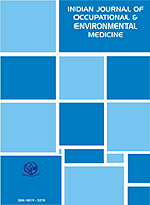
|
Indian Journal of Occupational and Environmental Medicine
Medknow Publications
ISSN: 0973-2284
EISSN: 0973-2284
Vol. 11, No. 2, 2007, pp. 56-60
|
 Bioline Code: oe07012
Bioline Code: oe07012
Full paper language: English
Document type: Research Article
Document available free of charge
|
|
|
Indian Journal of Occupational and Environmental Medicine, Vol. 11, No. 2, 2007, pp. 56-60
| en |
Methylene chloride exposure and carboxyhemoglobin levels in cabinetmakers
Banjoko, Sunny O; Sridhar, Mynapelli KC; Ogunkola, Isiah O & Masheyi, Olatunde O
Abstract
Methylene chloride (MeCl 2) is a clear colorless volatile sweet smelling lipophilic solvent used as a constituent of wood vanishes and paints. Human exposure is mainly due to inhalation and its biotransformation by the hepatic mixed function oxidases (MFO) leads to formation of carbon monoxide (CO). Simultaneous exposure to MeCl 2 and increased ambient CO results in undesirably increased carboxyhemoglobin (COHb) formation, which predisposes to carboxyhemoglobinaemia with the central nervous system as the primary target organ of toxicity.
In this study, ambient CO levels were determined using a CO personal monitor in different pasts of Ibadan Nigeria and work place microenvironment of 50 Cabinet makers (test group) and 50 volunteer (control) in non-furniture making occupations. Mann Whitney U and Kruskaal Wallis were the statistical methods of analysis used.
Questionnaires were administered to both groups carboxyhaemoglobin levels were determined in venous blood drawn from individuals in the two groups by differential spectrophotometric method.
Ambient CO levels in Ibadan were observed to be between 4 and 52 ppm with a mean of 20 ppm. Work environment CO levels were significantly higher in test subjects than controls at 5.2 ± 1.08 ppm and 2.08 ± 0.91 ppm respectively ( P < 0.001). COHb in cabinetmakers with mean working hours of 9.48 ± 2.9 per day was 3.95 ± 1.35 (%) while that of controls with mean working hours of 8.0 ± 0.8 per day was 2.08 ± 0.91 ppm ( P < 0.001). Smoking however did not significantly affect the COHb levels within the two groups ( P >0.05).
It is therefore imperative to substitute MeCl 2 for safer chemicals in wood vanish and paints and the use of protective gas masks and adequate ventilation should be mandatory whenever MeCl 2 is used.
Keywords
Carbon monoxide, carboxyhaemoglobin, methylene chloride
|
| |
© Copyright 2007 Indian Journal of Occupational and Environmental Medicine.
Alternative site location: http://www.ijoem.com
|
|
